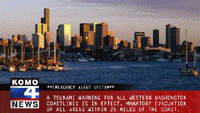
It’s a quiet day in Seattle when without warning an earthquake somewhere in the Pacific Ocean generates a tsunami aimed squarely at the city’s downtown.
Massive injuries and death are averted, however, thanks to the initial early warning and continuous updates area residents receive via OTA television transmission of warnings and rich media with their Mobile Emergency Alert System (M-EAS)-enabled Mobile-DTV handsets.
This Seattle tsunami is not the subject of a new disaster movie, but rather one of four emergency scenarios presented at the 2012 International CES in mid-January to demonstrate how an extension of the Emergency Alert System that takes advantage of newly emerging Mobile-DTV transmission system could help warn and direct the public to safety in times of emergency.
Backwards compatible with the ATSC A/153 Mobile DTV standard, M-EAS is currently in the first phase of a trial involving PBS, three public broadcasters — WGBH in Boston, Vegas PBS and Alabama Public Television — Harris, LG Electronics and Roundbox. Funding for the project is being provided by the Corporation for Public Broadcasting, LG Electronics and its subsidiary Zenith.
Jim Kutzner, chief engineer of PBS, who spearheaded the CES demonstration and is taking a lead role in the M-EAS trial, says that the success of the new standard will rely upon the acceptance of both the public and commercial broadcasters. “We have already started trying to be as inclusive of commercial broadcasters and others as we are of public broadcasters,” says Kutzner. “This can’t just be a public-TV thing. It has to be suitable for all TV stations.”
To that end, Kutzner enlisted Fisher Broadcasting VP of technology Brian McHale, and the company’s flagship station KOMO-TV in Seattle, for help with the CES demo. “KOMO, our ABC affiliate, created a scenario about what would occur if a tsunami came ashore in downtown Seattle,” says McHale.
The station built warning graphics and text-based alert information, as well as put together follow-up revisions to identify the precise areas where the tsunami would come ashore. It created warnings to evacuate to higher ground and other emergency information to assist the public as it evacuated the area, he says. “We also gave viewers a chance to see maps of the areas impacted, provided earthquake information and warnings about specific communities most at risk. We walked through the whole scenario of what would happen,” adds McHale.
The professional video industry's #1 source for news, trends and product and tech information. Sign up below.
The tsunami scenario, along with other M-EAS warnings, including a tornado scenario from WGBH, an Amber Alert scenario created by Alabama Public Television and a warning about a suspicious package found at the Las Vegas Convention Center were broadcast to LG Electronics handsets equipped with Mobile-DTV receivers and special software to decode the M-EAS messages.
M-EAS offers several powerful advantages, including the one-to-many architecture of the broadcast mobile; the ability to receive timely, critical warnings while on the move; and access to technologies previously unavailable to broadcasters, such as geo-targeting and delivery of non-real-time (NRT) data that can supplement warnings with other valuable information. To notify Mobile-DTV viewers that an emergency situation is developing, M-EAS also provides for display of a message of up to 90 characters in length in an on-screen banner.
At the 2012 NAB Show in Las Vegas, Kutzner plans to repeat his demonstration of M-EAS. Between now and then, he will continue working to achieve five specific goals set out for the trial.
Editor’s note: See the March 1, 2012, issue of RF Update for Part two of this report, which examines the goals set out for the M-EAS trial and what will be required of broadcasters to implement M-EAS as part of their mobile-DTV rollout when approved.
Phil Kurz is a contributing editor to TV Tech. He has written about TV and video technology for more than 30 years and served as editor of three leading industry magazines. He earned a Bachelor of Journalism and a Master’s Degree in Journalism from the University of Missouri-Columbia School of Journalism.

